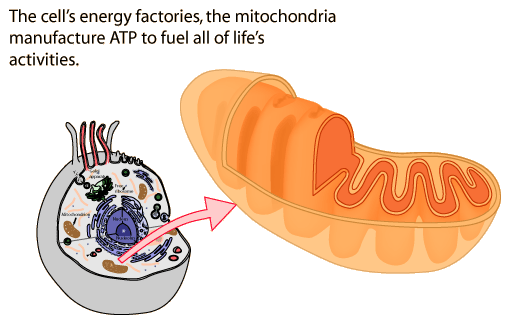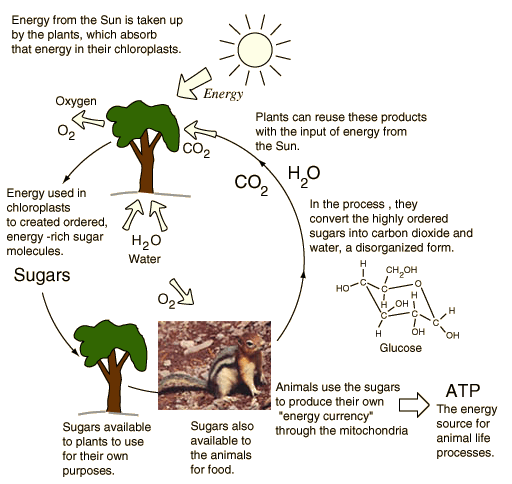
Mitochondria are the energy factories of the cells. The energy currency for the work that animals must do is the energy-rich molecule adenosine triphosphate (ATP). The ATP is produced in the mitochondria using energy stored in food. Just as the chloroplasts in plants act as sugar factories for the supply of ordered molecules to the plant, the mitochondria in animals and plants act to produce the ordered ATP molecules as the energy supply for the processes of life.
A typical animal cell will have on the order of 1000 to 2000 mitochondria. So the cell will have a lot of structures that are capable of producing a high amount of available energy. This ATP production by the mitochondria is done by the process of respiration, which in essence is the use of oxygen in a process which generates energy. This is a very efficient process for using food energy to make ATP. One of the benefits of "aerobic exercise" is that it improves your body's ability to make ATP rapidly using the respiration process.
All living cells have mitochondria. Hair cells and outer skin cells are dead cells and no longer actively producing ATP, but all cells have the same structure. Some cells have more mitochondria than others. Your fat cells have many mitochondria because they store a lot of energy. Muscle cells have many mitochondria, which allows them to respond quickly to the need for doing work. Mitochondria occupy 15 to 20 percent of mammalian liver cells according to Karp.
Energy Cycle in Living Things
A fascinating parallel between plant and animal life is in the use of tiny energy factories within the cells to handle the energy transformation processes necessary for life. In plants, these energy factories are called chloroplasts. They collect energy from the sun and use carbon dioxide and water in the process called photosynthesis to produce sugars. Animals can make use of the sugars provided by the plants in their own cellular energy factories, the mitochondria. These produce a versatile energy currency in the form of adenosine triphosphate (ATP). This high-energy molecule stores the energy we need to do just about everything we do.

A typical animal cell will have on the order of 1000 to 2000 mitochondria. So the cell will have a lot of structures that are capable of producing a high amount of available energy. This ATP production by the mitochondria is done by the process of respiration, which in essence is the use of oxygen in a process which generates energy. This is a very efficient process for using food energy to make ATP. One of the benefits of "aerobic exercise" is that it improves your body's ability to make ATP rapidly using the respiration process.
All living cells have mitochondria. Hair cells and outer skin cells are dead cells and no longer actively producing ATP, but all cells have the same structure. Some cells have more mitochondria than others. Your fat cells have many mitochondria because they store a lot of energy. Muscle cells have many mitochondria, which allows them to respond quickly to the need for doing work. Mitochondria occupy 15 to 20 percent of mammalian liver cells according to Karp.
Energy Cycle in Living Things
A fascinating parallel between plant and animal life is in the use of tiny energy factories within the cells to handle the energy transformation processes necessary for life. In plants, these energy factories are called chloroplasts. They collect energy from the sun and use carbon dioxide and water in the process called photosynthesis to produce sugars. Animals can make use of the sugars provided by the plants in their own cellular energy factories, the mitochondria. These produce a versatile energy currency in the form of adenosine triphosphate (ATP). This high-energy molecule stores the energy we need to do just about everything we do.



